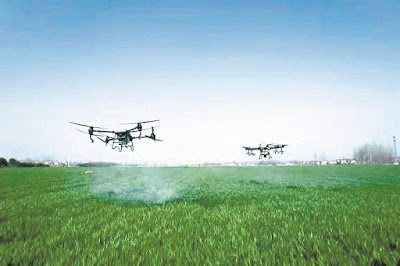
What is a UAV?
UAV is short for Unmanned Aerial Vehicle. UAV is rather technical, its common name is Drone. A UAV refers to an aircraft without any human on board (neither pilot nor passengers). Instead, it is operated controled through radio remote control equipment and a pre-installed program.
From the technical perspective, UAVs can be classified into: unmanned fixed-wing aircraft, unmanned vertical take-off and landing aircraft, unmanned airships, unmanned helicopters, unmanned multi-rotor aircraft, unmanned para-wing aircraft, etc. Compared with manned aircraft, it has the advantages of small size, low cost, convenient use, low requirements for the combat environment, and strong battlefield survivability.
Due to the importance of unmanned aircraft for future air warfare, major military powers in the world are stepping up the development of UAVs. In November 2013, the Civil Aviation Administration of China issued the "Interim Regulations on the Management of Civil Unmanned Aircraft System Pilots", and the China AOPA Association is responsible for the related management of civilian drones. According to the "Regulations", the operation of drones in mainland China can be divided into 11 situations according to the size of the aircraft type and the flying airspace. Among them, only drones of 116 kg or more and airships of 4,600 cubic meters or more flying in the converged airspace are managed by the Civil Aviation Administration. , The rest, including other flights including the increasingly popular miniature aerial vehicles, are managed by industry associations or by the operators themselves.
UAV Models & Classification
UAV technology sees rapid development in recent years. The wide variety of UAV systems, the distinctive features and their wide range of uses have resulted in great differences in size, quality, range, flight duration, flight altitude, flight speed, and missions. Due to the diversity of drones, there are different classification methods for different considerations:
(1) According to the flight platform configuration, UAVs can be divided into fixed-wing UAVs, rotary-wing UAVs, unmanned airships, para-wing UAVs, and flapping-wing UAVs.
(2) Classified by purpose, UAVs can be divided into military UAVs and civilian UAVs. Military UAVs can be divided into reconnaissance UAVs, decoy UAVs, electronic countermeasure UAVs, communication relay UAVs, unmanned fighter jets and drones, etc.; civilian UAVs can be divided into inspection/surveillance unmanned Drones, agricultural drones, meteorological drones, exploration drones, surveying drones, etc.
(3) According to scale classification (civil aviation regulations), UAVs can be divided into micro UAVs, light UAVs, small UAVs and large UAVs. Micro drone refers to a drone with an airborne mass of less than or equal to 7kg, a light drone with a mass of greater than 7kg, but less than or equal to 116kg, and in full-horsepower level flight, the corrected airspeed is less than 100km/h (55nmile/h), The ceiling is less than 3000m. Small drones refer to drones with an airborne mass of 5700kg or less, except for micro and light drones. Large drones refer to drones with an empty aircraft mass greater than 5700kg.
(4) According to the radius of activity, UAVs can be divided into ultra-short-range UAVs, short-range UAVs, short-range UAVs,
(5) Medium-range drones and long-range drones. The active radius of ultra-short-range UAVs is within 15km, the active radius of short-range UAVs is between 15-50km, the radius of short-range UAVs is between 50-200km, and the radius of medium-range UAVs is 200-800km. In between, the long-range UAV has a radius of activity greater than 800km.
(6) Classified by mission height, drones can be divided into ultra-low-altitude drones, low-altitude drones, medium-altitude drones,
(7) High-altitude drones and ultra-high-altitude drones. The mission height of ultra-low-altitude drones is generally between 0 and loom, the mission height of low-altitude drones is generally between 100 and 1000m, the mission height of medium-altitude drones is generally between 1000 and 7000m, and the mission height of high-altitude drones is general. Between 7000 and 18000m, the mission height of the ultra-high-altitude UAV is generally greater than 18000m. [9]
In September 2018, the 62nd meeting of the Harmonized System Committee (HSC) of the World Customs Organization decided to classify drones as "flying cameras". As UAVs are categorized as "flying cameras" and thus they can be supervised under the category of "cameras".




No comments:
Post a Comment